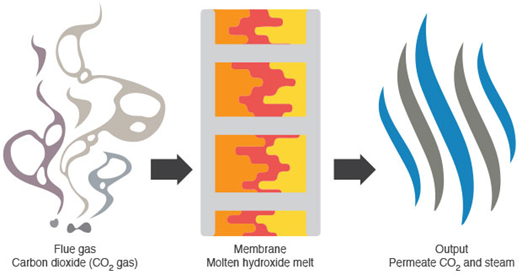Porous ceramic materials have a host of potential use cases including filtration, catalyst supports, lightweight high strength building materials, substrates for cell growth. One specific use case which holds great promise is their use as dual phase ceramic membranes. Dual-phase (liquid/solid) membranes can be suitable for many separation applications. The liquid phase is supported inside the nano/micro-pore network of the solid phase by capillary forces. Additionally, in some applications, the solid support would need to be able to withstand exposure to corrosive, acidic, and/or various solvents; porous ceramic membranes would be good candidates for these applications as they are inherently chemically inert.
One specific application of dual-phase ceramic membranes is post-combustion selective CO2 separation from power generation flue gases, producing CO2-enriched streams suitable for sequestration or use as chemical feedstock. These porous ceramics could provide support for highly corrosive molten hydroxide salts as part of a dual-phase membrane system for CO2 separation.
Another application of dual-phase ceramic membranes would be for their use in alkaline fuel cells or a thermo-electrochemical CO2 reactive capture fuel cells. Alkaline fuel cells (AFCs) use an aqueous potassium hydroxide electrolyte, and a variety of non-precious metal catalysts at the anode and cathode. More recently, AFCs have used a polymer membrane as the electrolyte. The AFCs have demonstrated efficiencies above 60% in space applications, but because the AFC is susceptible to poisoning by carbon dioxide (CO2), oxygen purity is critical. Carbonate formation from even a small amount of CO2 can dramatically affect cell performance and durability. CO2 reactive capture fuel cells combine carbon absorption and conversion steps into one device and provide opportunity for more distributed and flexible carbon management. To date, there are only a few examples of attempted integration within the same device. Of these demonstrations, almost all suffer from significant drawbacks including short operating lifetimes, use of toxic or expensive catalysts, high temperature (>500 °C) operation, and undesired carbon buildup on electrodes.
Facing these challenges, LLNL researchers focused on ceramic material as it is inherently inert and developed a host of inventions where porous ceramic membranes are prepared using a sacrificial polymer template. By controlling polymer/ceramic nanoparticle ratio and processing conditions, the pore morphology of the ceramic itself is controlled and optimized for the various applications. The sacrificial polymer/metal-oxide synthesis protocol enables enhanced control of the pore morphology of the resulting porous ceramic parts. The use of liquid resin, which can be heat- or photo-polymerized, enables the ceramic part to be cast in molds of arbitrary shape and size. This novel approach is generally applicable to any metal-oxide particles that can be fused by sintering.
These porous ceramics can support highly corrosive molten hydroxide salts as part of a dual-phase ceramic membrane for CO2 separation. Molten hydroxide-ceramic dual phase (HCDP) membrane is also shown to be beneficial when used in an alkaline fuel cell (AFC) to prevent carbonate buildup in the fuel cell membrane. HCDP continuous membrane operation has been demonstrated for more than 11 days at much higher CO2 concentrations than are found in air. Also, reversible CO2 uptake and release from HCDP membranes at temperatures as low as 300 °C has been demonstrated.
In the CO2 reactive capture (RC) fuel cells incorporating HCDP membrane technology can enable selective removal of CO2 from dilute sources (e.g., power plant flue gas, bio-gas, coproduced CO2 with natural gas, air) and convert it directly to syngas (CO + H2) in just one step and in a single device. The invention adds electrocatalysts to the membrane which convert CO2 to syngas that can then be used to create a variety of value-added products.
Image Caption: A gas separation membrane containing the optimized molten hydroxide solution held in a porous material selectively turns CO2 into carbonates, which are transported across the membrane by diffusion. Water—as steam—on the sweep (right) side is critical for recovering the captured carbon for storage by converting the carbonate back into CO2.
The porous ceramic material synthesis protocol enables enhanced control of pore morphology at both the nanoscale and microscale. The use of liquid resin, which can be heat- or photo-polymerized, enables the ceramic part to be cast in molds of arbitrary shape and size.
For CO2 capture applications, HCDP membranes allow for the separation of CO2 from flue gas while it’s still hot, therefore reducing the energy requirements of current CO2 scrubbing technologies.
HDCP membrane technology can also work at operating conditions in the intermediate temperature range allowable for alkaline fuel cells, thus eliminating any additional steps for CO2 removal from air feed.
For CO2 RC fuel cells with HCDP membranes, the combination of dual-phase membrane-based separation and thermo- and electrocatalytic conversion increases selectivity, efficiency, and performance, and makes this platform uniquely tunable and adaptable to a variety input streams and output products.
- CO2 Capture, Utilization and Storage (with a molten salt phase)
- Fuel Cells.
- High Efficiency Particulate Air (HEPA) filtration.
- Catalyst Support.
- Lightweight, High-Strength Building Materials.
- Substrates for Cell Growth.
Current stage of technology development: TRL 2-3
LLNL has patent(s) on this invention.
U.S. Patent No. 10464015 MOLTEN HYDROXIDE MEMBRANE FOR SEPARATION OF ACID GASES FROM EMISSIONS published 11/5/2019
U.S. Patent No. 11260343 MOLTEN HYDROXIDE MEMBRANE FOR SEPARATION OF ACID GASES FROM EMISSIONS published 3/1/2021
U.S. Patent No. 11260344 MOLTEN HYDROXIDE MEMBRANE FOR SEPARATION OF ACID GASES FROM EMISSIONS published 3/1/2022
U.S. Patent No. 11142486 POROUS CERAMIC STRUCTURE FOR CARBON DIOXIDE CAPTURE published 10/12/2021
U.S. Patent No. 11638907 POROUS CERAMICS FOR ADDITIVE MANUFACTURING, FILTRATION, AND MEMBRANE APPLICATIONS published 5/2/2023
U.S. Patent Application No. 2023/0219058 POROUS CERAMICS FOR ADDITIVE MANUFACTURING, FILTRATION, AND MEMBRANE APPLICATIONS published 7/13/2023
U.S. Patent Application No. 2019/0379063 MOLTEN ELECTROLYTE DUAL-PHASE MEMBRANES FOR INTERMEDIATE TEMPERATURE FUEL CELLS published 12/12/2019
U.S. Patent Application No. 2022/0178036 SEPARATION AND CONVERSION OF CARBON DIOXIDE TO SYNGAS USING A POROUS CERAMIC DUAL MEMBRANE IN A THERMO-ELECTROCHEMICAL REACTOR published 6/9/2022


